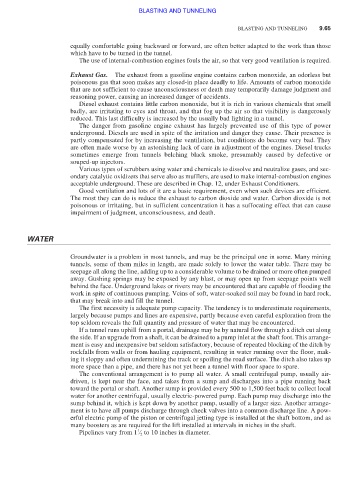Page 465 - Moving the Earth_ The Workbook of Excavation
P. 465
BLASTING AND TUNNELING
BLASTING AND TUNNELING 9.65
equally comfortable going backward or forward, are often better adapted to the work than those
which have to be turned in the tunnel.
The use of internal-combustion engines fouls the air, so that very good ventilation is required.
Exhaust Gas. The exhaust from a gasoline engine contains carbon monoxide, an odorless but
poisonous gas that soon makes any closed-in place deadly to life. Amounts of carbon monoxide
that are not sufficient to cause unconsciousness or death may temporarily damage judgment and
reasoning power, causing an increased danger of accidents.
Diesel exhaust contains little carbon monoxide, but it is rich in various chemicals that smell
badly, are irritating to eyes and throat, and that fog up the air so that visibility is dangerously
reduced. This last difficulty is increased by the usually bad lighting in a tunnel.
The danger from gasoline engine exhaust has largely prevented use of this type of power
underground. Diesels are used in spite of the irritation and danger they cause. Their presence is
partly compensated for by increasing the ventilation, but conditions do become very bad. They
are often made worse by an astonishing lack of care in adjustment of the engines. Diesel trucks
sometimes emerge from tunnels belching black smoke, presumably caused by defective or
souped-up injectors.
Various types of scrubbers using water and chemicals to dissolve and neutralize gases, and sec-
ondary catalytic oxidizers that serve also as mufflers, are used to make internal-combustion engines
acceptable underground. These are described in Chap. 12, under Exhaust Conditioners.
Good ventilation and lots of it are a basic requirement, even when such devices are efficient.
The most they can do is reduce the exhaust to carbon dioxide and water. Carbon dioxide is not
poisonous or irritating, but in sufficient concentration it has a suffocating effect that can cause
impairment of judgment, unconsciousness, and death.
WATER
Groundwater is a problem in most tunnels, and may be the principal one in some. Many mining
tunnels, some of them miles in length, are made solely to lower the water table. There may be
seepage all along the line, adding up to a considerable volume to be drained or more often pumped
away. Gushing springs may be exposed by any blast, or may open up from seepage points well
behind the face. Underground lakes or rivers may be encountered that are capable of flooding the
work in spite of continuous pumping. Veins of soft, water-soaked soil may be found in hard rock,
that may break into and fill the tunnel.
The first necessity is adequate pump capacity. The tendency is to underestimate requirements,
largely because pumps and lines are expensive, partly because even careful exploration from the
top seldom reveals the full quantity and pressure of water that may be encountered.
If a tunnel runs uphill from a portal, drainage may be by natural flow through a ditch cut along
the side. If an upgrade from a shaft, it can be drained to a pump inlet at the shaft foot. This arrange-
ment is easy and inexpensive but seldom satisfactory, because of repeated blocking of the ditch by
rockfalls from walls or from hauling equipment, resulting in water running over the floor, mak-
ing it sloppy and often undermining the track or spoiling the road surface. The ditch also takes up
more space than a pipe, and there has not yet been a tunnel with floor space to spare.
The conventional arrangement is to pump all water. A small centrifugal pump, usually air-
driven, is kept near the face, and takes from a sump and discharges into a pipe running back
toward the portal or shaft. Another sump is provided every 500 to 1,500 feet back to collect local
water for another centrifugal, usually electric-powered pump. Each pump may discharge into the
sump behind it, which is kept down by another pump, usually of a larger size. Another arrange-
ment is to have all pumps discharge through check valves into a common discharge line. A pow-
erful electric pump of the piston or centrifugal jetting type is installed at the shaft bottom, and as
many boosters as are required for the lift installed at intervals in niches in the shaft.
1
Pipelines vary from 1 ⁄ 2 to 10 inches in diameter.

